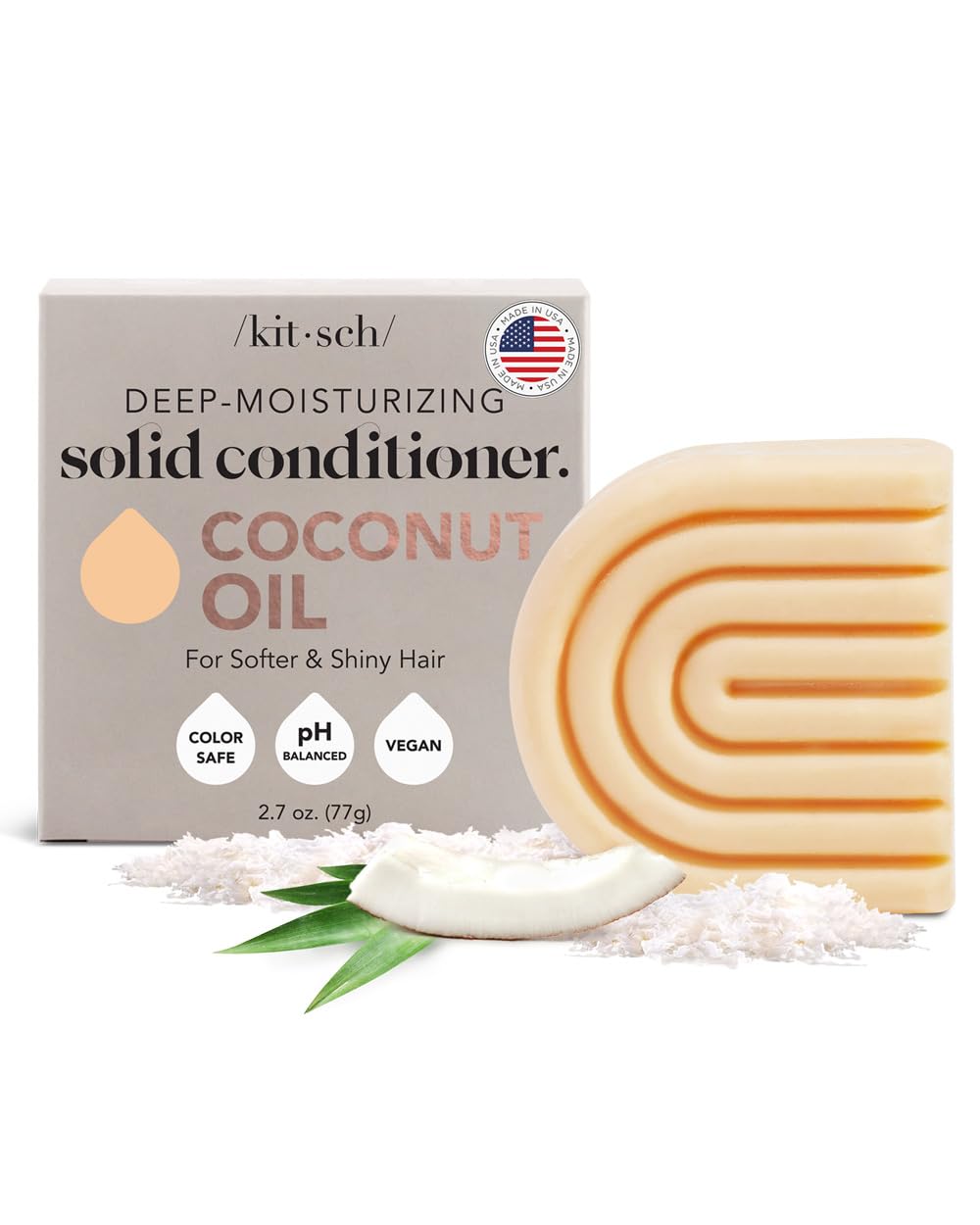
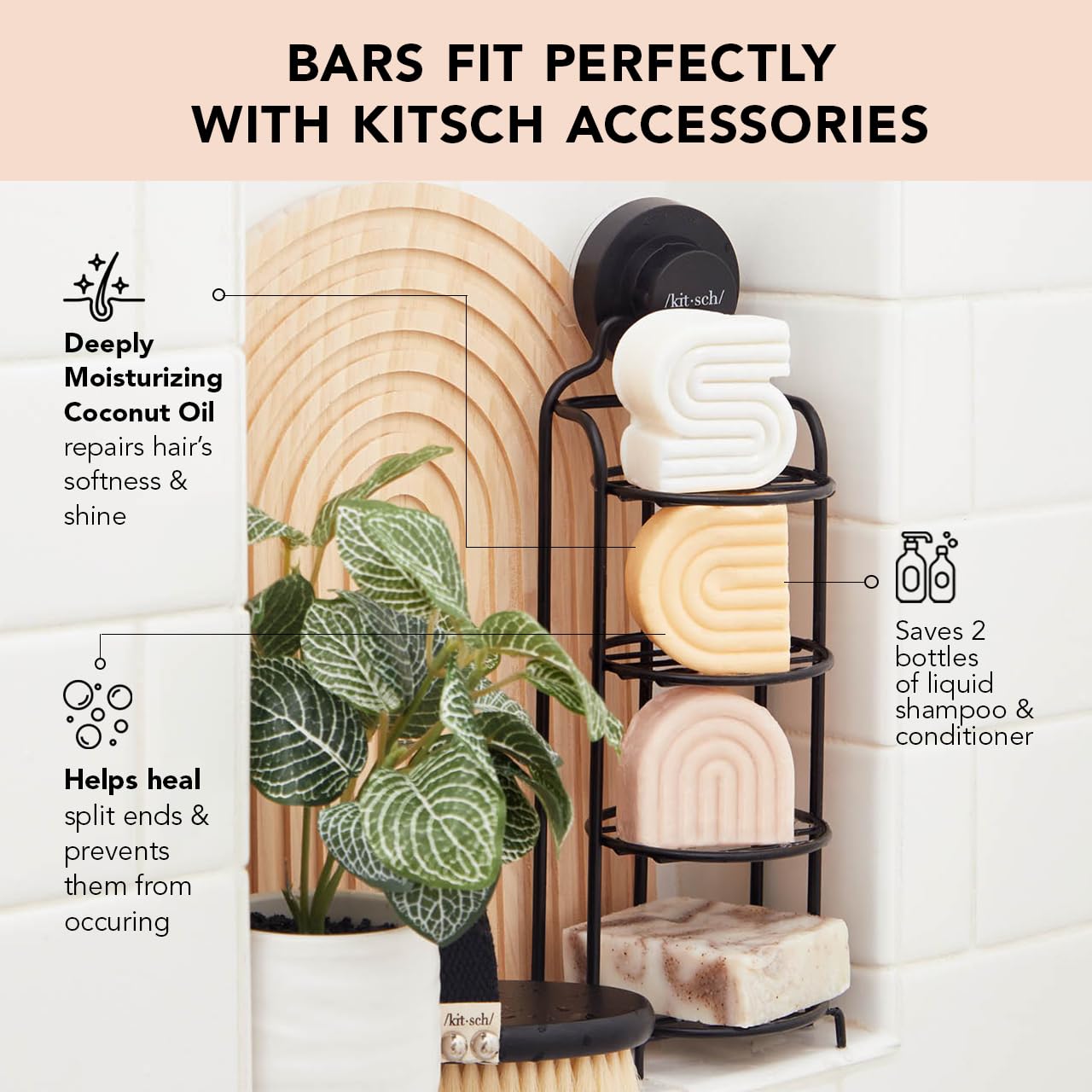
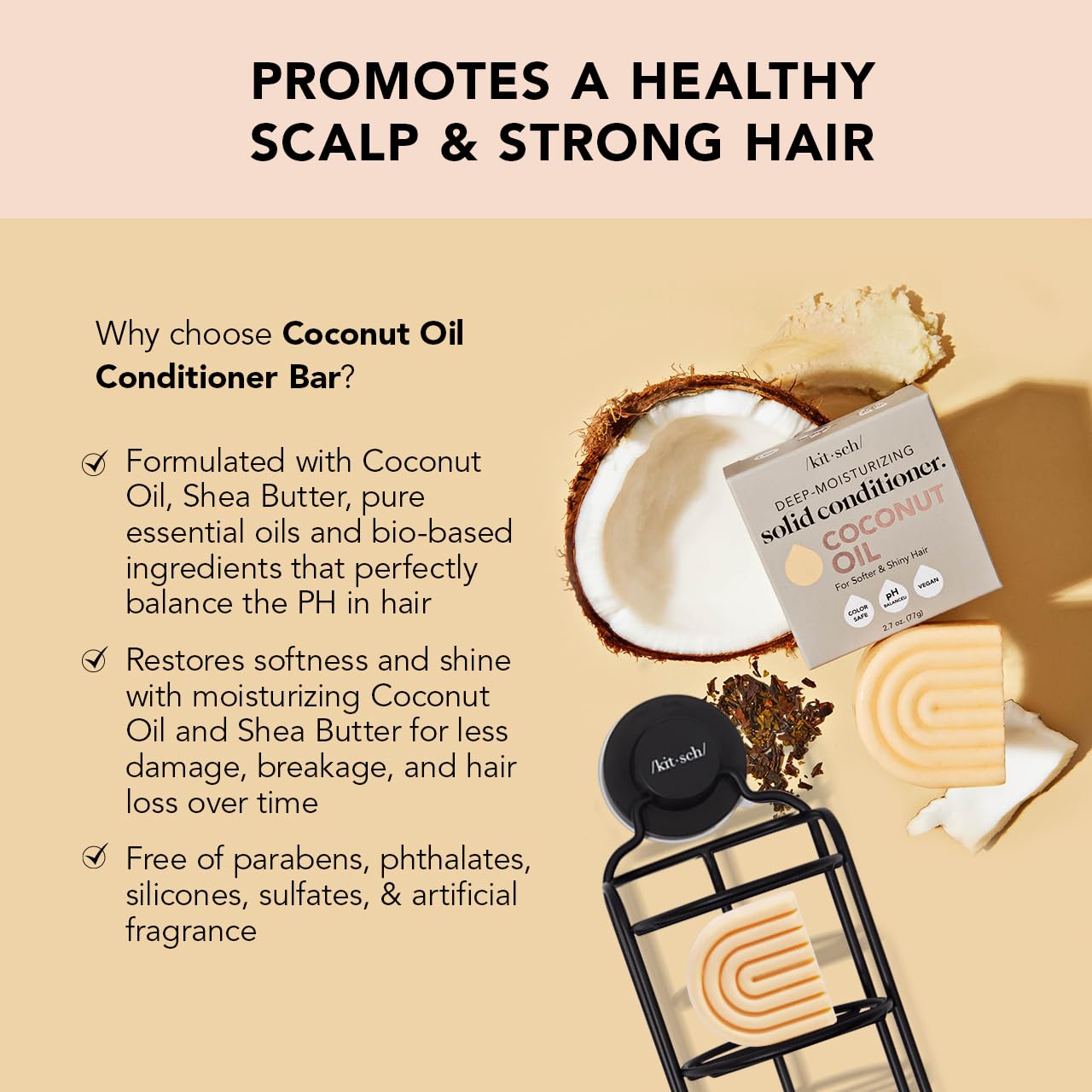
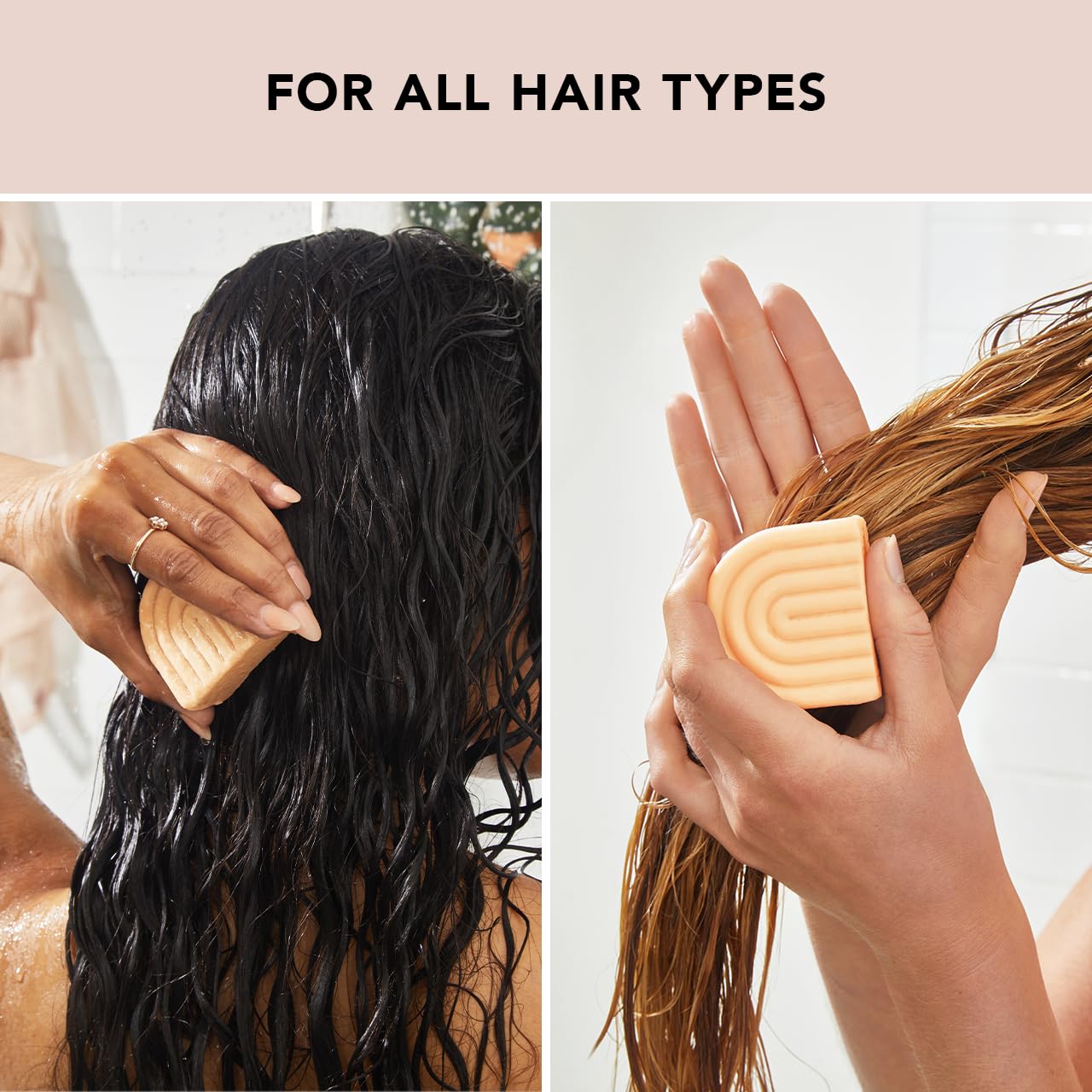


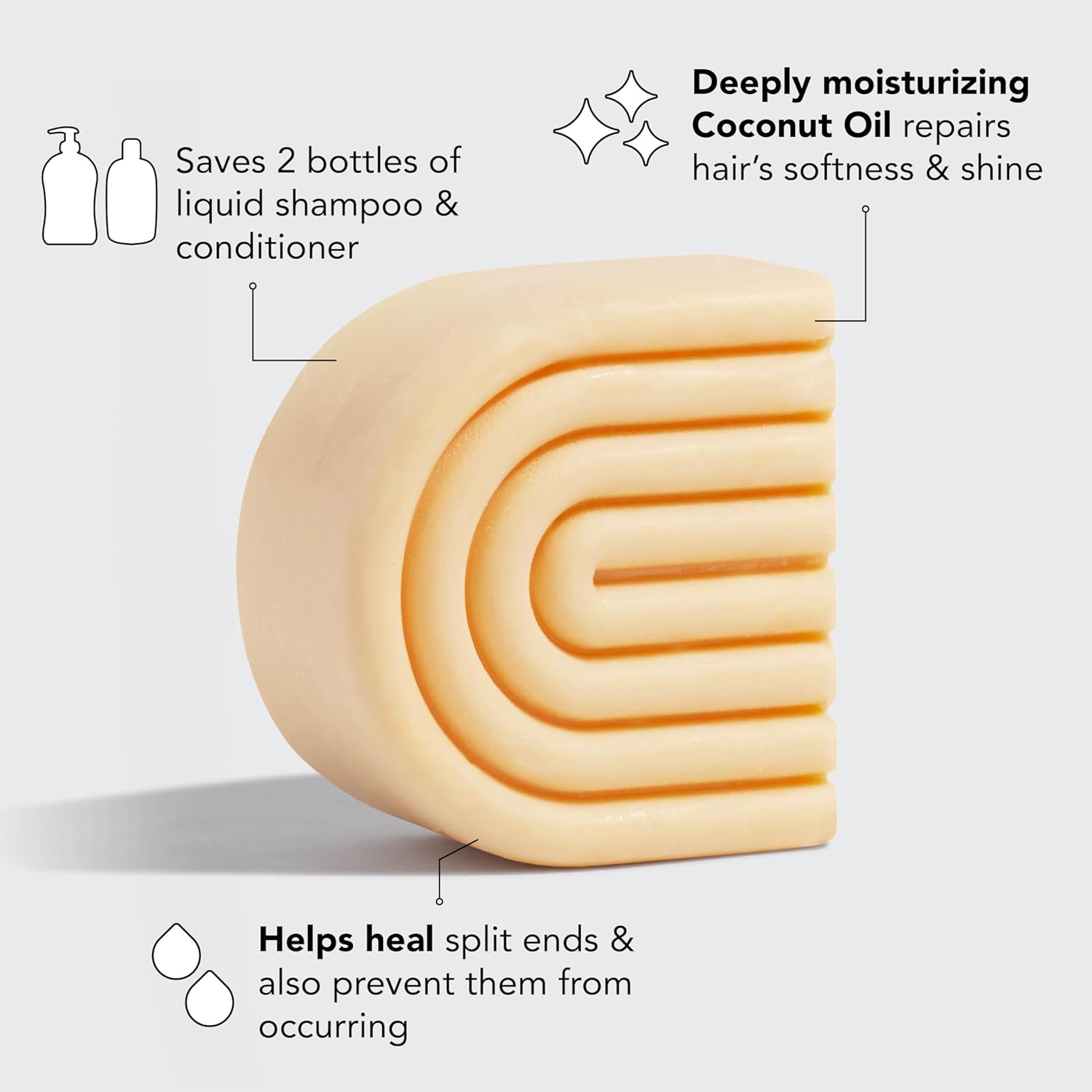
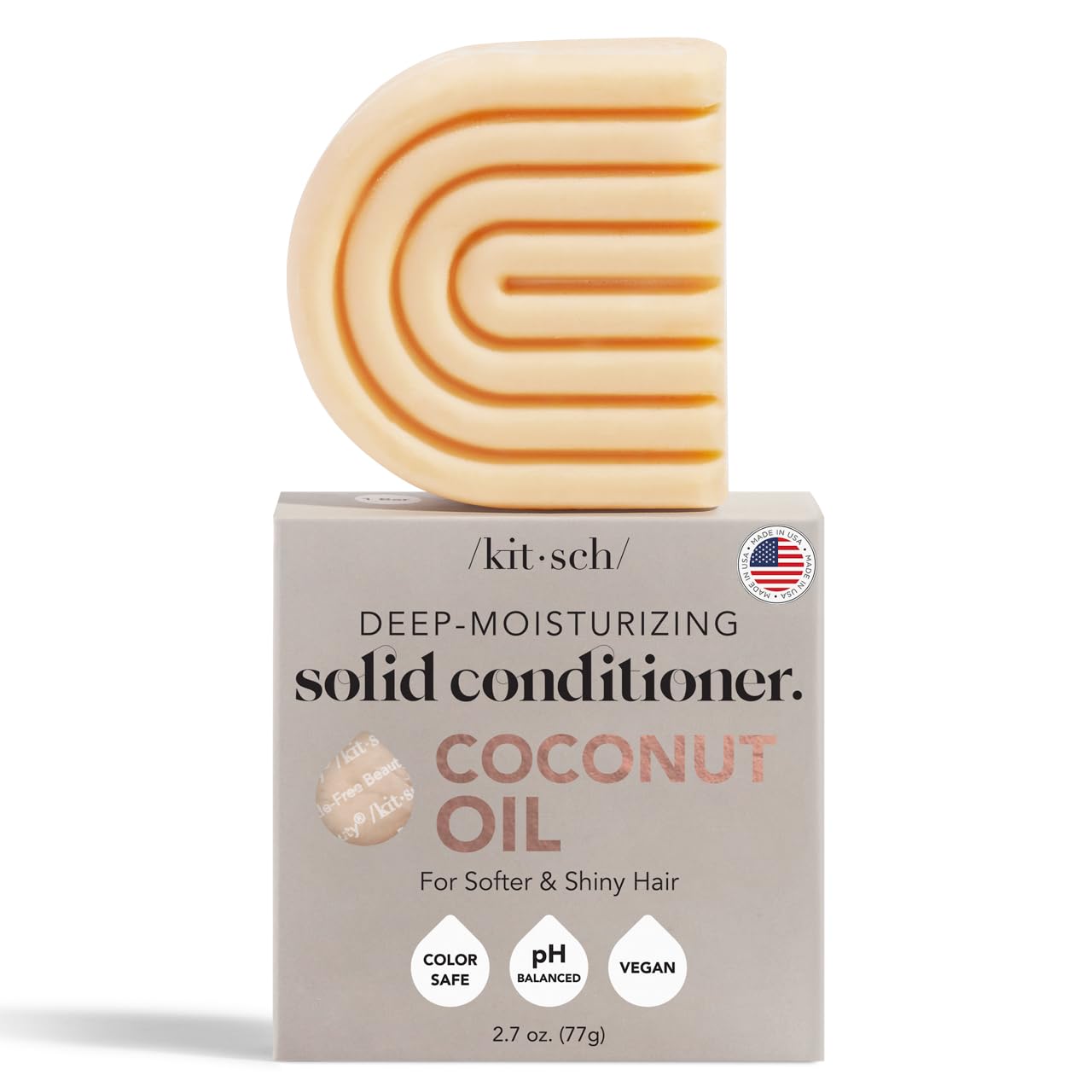
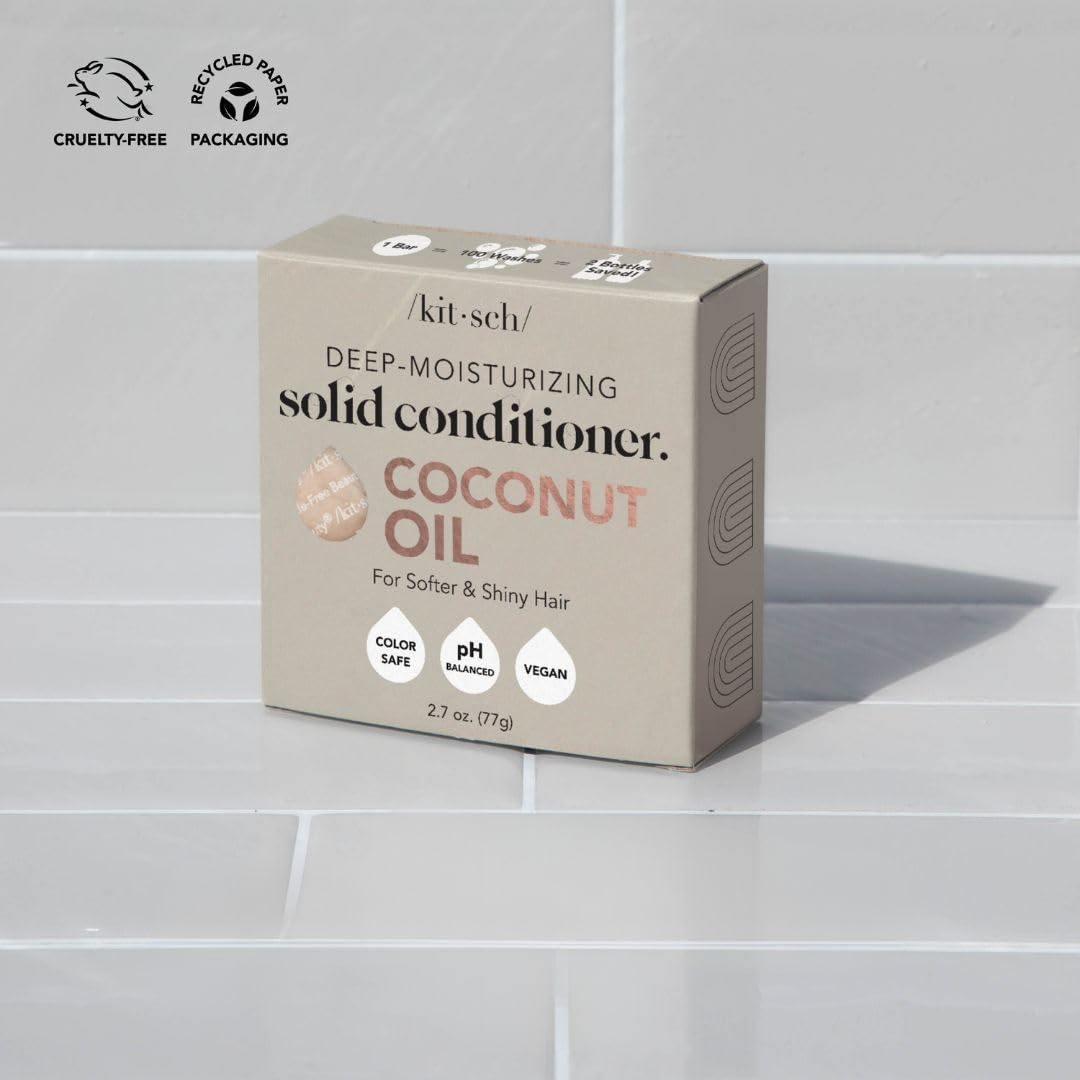
Kitsch Coconut Oil Conditioner Bar - Nourishes & Strengthens, Paraben Free - 2.7 oz


Behentrimonium Chloride
High RiskBehentrimonium chloride is a quaternary ammonium compound primarily used as a conditioning agent in hair and skin care products. It functions as an emulsifier and surfactant, helping to improve texture and manageability of hair.
Sustai Insights
Behentrimonium chloride offers functional benefits as a hair conditioner and emulsifier. However, it is associated with moderate allergenic potential and has high use restrictions due to regulatory concerns. It poses low risks for carcinogenicity and developmental toxicity but has been noted for neurotoxicity. Environmental risks include potential pollution and low biodegradability. Overall, the ingredient is assessed as high risk, and users should consider alternatives such as natural conditioners.
Titanium Dioxide
Medium RiskTitanium dioxide is an inorganic compound used primarily as a pigment due to its brightness and high refractive index. It is commonly found in products such as paints, coatings, plastics, and cosmetics, providing color and opacity.
Sustai Insights
Titanium dioxide serves effectively as a UV filter and colorant, enhancing product stability and performance. However, it has been classified as a moderate concern for potential carcinogenicity and carries low risks for allergies and reproductive toxicity. Environmental risks include its pollutant potential, though it is not known to bioaccumulate. Regulatory bodies have issued specific restrictions regarding its use, leading to an overall medium risk assessment. Safe usage practices should be observed, with consideration for alternatives such as zinc oxide for a more sustainable option.
Cocos Nucifera (Coconut)
Medium RiskCocos Nucifera, commonly known as coconut, is derived from the coconut palm. It is widely used in various cosmetic and personal care products for its moisturizing properties, acting as an emollient and skin-conditioning agent, enhancing texture and hydration.
Sustai Insights
Cocos Nucifera offers functional benefits such as effective moisturization and conditioning for the skin, while being biodegradable and often sustainably sourced. Health risks are minimal, with low concerns for carcinogenicity, allergies, and reproductive toxicity. Environmental risks are also low, as it does not accumulate in organisms or significantly pollute. Regulatory bodies do not impose restrictions, supporting its overall low-risk status. Safe usage practices include patch testing for sensitivities, though alternatives like shea butter or jojoba oil may offer similar benefits.
Cetearyl Alcohol
Low RiskCetearyl alcohol is a mixture of cetyl and stearyl alcohol, primarily used as an emulsifier and thickener in cosmetic formulations. It helps stabilize products, improve texture, and enhance moisturizing properties, making it common in creams and lotions.
Sustai Insights
Cetearyl alcohol offers functional benefits as an effective emulsifier and skin-conditioning agent, contributing to product stability and texture. It is generally recognized as safe, with low concerns for carcinogenicity, allergies, or reproductive toxicity. Environmental risks are minimal, as it is biodegradable and has low pollutant potential. Regulatory bodies have not imposed significant restrictions on its use. Overall, cetearyl alcohol is assessed to carry low risk, making it a suitable ingredient choice in cosmetic products.
Lauryl Laurate
Low RiskLauryl laurate is an ester derived from lauryl alcohol and lauric acid, commonly used in cosmetic formulations as an emollient and surfactant. It contributes to the texture and spreadability of products, enhancing their overall feel on the skin.
Sustai Insights
Lauryl laurate offers functional benefits as a skin-conditioning agent and emulsifier, contributing to product stability. It is considered low risk for health concerns such as carcinogenicity, allergies, and reproductive toxicity. Environmental assessments indicate minimal pollutant potential. Regulatory bodies do not impose significant restrictions. Overall, the ingredient is deemed low risk for use in cosmetic applications, with no specific alternatives identified.
Guar Hydroxypropyltrimonium Chloride
Low RiskGuar hydroxypropyltrimonium chloride is a quaternary ammonium compound derived from guar gum, primarily used as a conditioning agent in cosmetic products. It enhances the texture and feel of hair and skin formulations, providing moisture retention and improved manageability.
Sustai Insights
This ingredient offers functional benefits as a conditioning agent, improving the texture and moisture retention in formulations. It is considered low risk regarding health effects, with minimal concerns for carcinogenicity, allergies, or reproductive toxicity. Environmental risks are also low, as it does not accumulate significantly in ecosystems. Regulatory bodies have not imposed significant restrictions. Safe usage practices should be followed, but overall, this ingredient is assessed as low risk, with no immediate concerns regarding alternatives.
Helianthus Annuus (Sunflower) Seed
Low RiskHelianthus annuus (sunflower) seed is derived from the seeds of the sunflower plant and is commonly used in various cosmetic and personal care products. It serves primarily as an emollient and skin conditioning agent, providing moisture and enhancing the texture of formulations.
Sustai Insights
Helianthus annuus (sunflower) seed offers functional benefits, including skin conditioning and moisturizing properties, while being sustainably sourced and biodegradable. Health risks are minimal, with low concerns for carcinogenicity, allergies, and reproductive toxicity. Environmentally, it presents low risks of pollution or bioaccumulation. Regulatory assessments indicate no current restrictions. Overall, it is considered a low-risk ingredient, and safe usage practices should be maintained. Alternative ingredients may include other plant-based oils, but the sunflower seed oil remains a viable option.
Cocos Nucifera (Coconut) Oil
Low RiskCocos Nucifera (Coconut) Oil is derived from the kernels of the coconut palm. It is primarily used in cosmetic formulations for its emollient and moisturizing properties, making it suitable for skin and hair care products.
Sustai Insights
Coconut oil serves as an effective moisturizer and emollient, promoting skin hydration and softness. It is sustainably sourced and biodegradable. Health risks are minimal, with low concerns regarding carcinogenicity, allergens, and reproductive toxicity. Environmental impact is also low, as it does not contribute significantly to pollution or bioaccumulation. Regulatory bodies have not issued restrictions on its use. Overall, coconut oil presents a low risk for health and environmental concerns, making it a safe ingredient in cosmetic products.
White Tea
Low RiskWhite tea is derived from the leaves and buds of the Camellia sinensis plant, known for its delicate flavor and high antioxidant content. It is commonly used in cosmetic products for its potential skin-soothing properties, as well as in beverages for its health benefits.
Sustai Insights
White tea exhibits functional benefits, including antioxidant properties that may protect the skin from oxidative stress and support overall health. It is generally considered low risk regarding health impacts, with minimal concerns for carcinogenicity, allergies, or reproductive toxicity. Environmental risks are also low, as it is not known to contribute significantly to pollution or bioaccumulation. Regulatory status is favorable, with no current restrictions. Safe usage practices include moderation in application, and while alternatives exist, such as green tea, white tea remains a sustainable option. Overall, it is assessed as a low-risk ingredient.
Cetearyl Alcohol
Low RiskCetearyl alcohol is a mixture of cetyl and stearyl alcohol, primarily used as an emulsifier and thickener in cosmetic formulations. It helps stabilize products, improve texture, and enhance moisturizing properties, making it common in creams and lotions.
Sustai Insights
Cetearyl alcohol offers functional benefits as an effective emulsifier and skin-conditioning agent, contributing to product stability and texture. It is generally recognized as safe, with low concerns for carcinogenicity, allergies, or reproductive toxicity. Environmental risks are minimal, as it is biodegradable and has low pollutant potential. Regulatory bodies have not imposed significant restrictions on its use. Overall, cetearyl alcohol is assessed to carry low risk, making it a suitable ingredient choice in cosmetic products.
Titanium Dioxide
Medium RiskTitanium dioxide is an inorganic compound used primarily as a pigment due to its brightness and high refractive index. It is commonly found in products such as paints, coatings, plastics, and cosmetics, providing color and opacity.
Sustai Insights
Titanium dioxide serves effectively as a UV filter and colorant, enhancing product stability and performance. However, it has been classified as a moderate concern for potential carcinogenicity and carries low risks for allergies and reproductive toxicity. Environmental risks include its pollutant potential, though it is not known to bioaccumulate. Regulatory bodies have issued specific restrictions regarding its use, leading to an overall medium risk assessment. Safe usage practices should be observed, with consideration for alternatives such as zinc oxide for a more sustainable option.
Behentrimonium Chloride
High RiskBehentrimonium chloride is a quaternary ammonium compound primarily used as a conditioning agent in hair and skin care products. It functions as an emulsifier and surfactant, helping to improve texture and manageability of hair.
Sustai Insights
Behentrimonium chloride offers functional benefits as a hair conditioner and emulsifier. However, it is associated with moderate allergenic potential and has high use restrictions due to regulatory concerns. It poses low risks for carcinogenicity and developmental toxicity but has been noted for neurotoxicity. Environmental risks include potential pollution and low biodegradability. Overall, the ingredient is assessed as high risk, and users should consider alternatives such as natural conditioners.
Cocos Nucifera (Coconut)
Medium RiskCocos Nucifera, commonly known as coconut, is derived from the coconut palm. It is widely used in various cosmetic and personal care products for its moisturizing properties, acting as an emollient and skin-conditioning agent, enhancing texture and hydration.
Sustai Insights
Cocos Nucifera offers functional benefits such as effective moisturization and conditioning for the skin, while being biodegradable and often sustainably sourced. Health risks are minimal, with low concerns for carcinogenicity, allergies, and reproductive toxicity. Environmental risks are also low, as it does not accumulate in organisms or significantly pollute. Regulatory bodies do not impose restrictions, supporting its overall low-risk status. Safe usage practices include patch testing for sensitivities, though alternatives like shea butter or jojoba oil may offer similar benefits.
Lauryl Laurate
Low RiskLauryl laurate is an ester derived from lauryl alcohol and lauric acid, commonly used in cosmetic formulations as an emollient and surfactant. It contributes to the texture and spreadability of products, enhancing their overall feel on the skin.
Sustai Insights
Lauryl laurate offers functional benefits as a skin-conditioning agent and emulsifier, contributing to product stability. It is considered low risk for health concerns such as carcinogenicity, allergies, and reproductive toxicity. Environmental assessments indicate minimal pollutant potential. Regulatory bodies do not impose significant restrictions. Overall, the ingredient is deemed low risk for use in cosmetic applications, with no specific alternatives identified.
Guar Hydroxypropyltrimonium Chloride
Low RiskGuar hydroxypropyltrimonium chloride is a quaternary ammonium compound derived from guar gum, primarily used as a conditioning agent in cosmetic products. It enhances the texture and feel of hair and skin formulations, providing moisture retention and improved manageability.
Sustai Insights
This ingredient offers functional benefits as a conditioning agent, improving the texture and moisture retention in formulations. It is considered low risk regarding health effects, with minimal concerns for carcinogenicity, allergies, or reproductive toxicity. Environmental risks are also low, as it does not accumulate significantly in ecosystems. Regulatory bodies have not imposed significant restrictions. Safe usage practices should be followed, but overall, this ingredient is assessed as low risk, with no immediate concerns regarding alternatives.
Helianthus Annuus (Sunflower) Seed
Low RiskHelianthus annuus (sunflower) seed is derived from the seeds of the sunflower plant and is commonly used in various cosmetic and personal care products. It serves primarily as an emollient and skin conditioning agent, providing moisture and enhancing the texture of formulations.
Sustai Insights
Helianthus annuus (sunflower) seed offers functional benefits, including skin conditioning and moisturizing properties, while being sustainably sourced and biodegradable. Health risks are minimal, with low concerns for carcinogenicity, allergies, and reproductive toxicity. Environmentally, it presents low risks of pollution or bioaccumulation. Regulatory assessments indicate no current restrictions. Overall, it is considered a low-risk ingredient, and safe usage practices should be maintained. Alternative ingredients may include other plant-based oils, but the sunflower seed oil remains a viable option.
Cocos Nucifera (Coconut) Oil
Low RiskCocos Nucifera (Coconut) Oil is derived from the kernels of the coconut palm. It is primarily used in cosmetic formulations for its emollient and moisturizing properties, making it suitable for skin and hair care products.
Sustai Insights
Coconut oil serves as an effective moisturizer and emollient, promoting skin hydration and softness. It is sustainably sourced and biodegradable. Health risks are minimal, with low concerns regarding carcinogenicity, allergens, and reproductive toxicity. Environmental impact is also low, as it does not contribute significantly to pollution or bioaccumulation. Regulatory bodies have not issued restrictions on its use. Overall, coconut oil presents a low risk for health and environmental concerns, making it a safe ingredient in cosmetic products.
White Tea
Low RiskWhite tea is derived from the leaves and buds of the Camellia sinensis plant, known for its delicate flavor and high antioxidant content. It is commonly used in cosmetic products for its potential skin-soothing properties, as well as in beverages for its health benefits.
Sustai Insights
White tea exhibits functional benefits, including antioxidant properties that may protect the skin from oxidative stress and support overall health. It is generally considered low risk regarding health impacts, with minimal concerns for carcinogenicity, allergies, or reproductive toxicity. Environmental risks are also low, as it is not known to contribute significantly to pollution or bioaccumulation. Regulatory status is favorable, with no current restrictions. Safe usage practices include moderation in application, and while alternatives exist, such as green tea, white tea remains a sustainable option. Overall, it is assessed as a low-risk ingredient.
Experience the nourishing power of the Kitsch Coconut Oil Deep-Moisturizing Hair Conditioner Bar. This eco-friendly, zero-waste conditioner is perfect for dry, damaged hair, delivering salon-quality moisture without harmful chemicals.
- Nourishing Formula: This conditioner bar hydrates and strengthens hair, promoting healthy, shiny locks with minimal breakage.
- Gentle and Safe: Free from sulfates, parabens, and silicones, it’s formulated to be gentle enough for daily use, reducing irritation for all hair types.
- Eco-Conscious Choice: By choosing this solid conditioner, you save the equivalent of two plastic bottles, supporting a sustainable lifestyle and reducing waste.
- Easy Application: Simply rub the bar between your hands or apply directly to your hair, providing a silky slip that makes detangling effortless.
- Versatile Use: Works wonderfully as a leave-in treatment for extra hydration or as a deep conditioner for a restorative boost.
Transform your hair care routine with this powerful, eco-friendly solution, designed for the environmentally and health-conscious consumer.
Subscribe & Save with Sustai
- Best Price Guarantee: Always enjoy the lowest prices on sustainable home essentials.
- No Surprises: We’ll notify you before shipping. No hidden fees, ever.
- You’re in Charge: Change, pause, or cancel your subscription anytime with ease.
- Eco-Friendly Deliveries: Our grouped shipments mean less packaging and lower emissions.
Join us on a sustainable journey. Special offers for a limited time! Prices and promotions may change.
Recommended Products
Experience the nourishing power of the Kitsch Coconut Oil Deep-Moisturizing Hair Conditioner Bar. This eco-friendly, zero-waste conditioner is perfect for dry, damaged hair, delivering salon-quality moisture without harmful chemicals.
- Nourishing Formula: This conditioner bar hydrates and strengthens hair, promoting healthy, shiny locks with minimal breakage.
- Gentle and Safe: Free from sulfates, parabens, and silicones, it’s formulated to be gentle enough for daily use, reducing irritation for all hair types.
- Eco-Conscious Choice: By choosing this solid conditioner, you save the equivalent of two plastic bottles, supporting a sustainable lifestyle and reducing waste.
- Easy Application: Simply rub the bar between your hands or apply directly to your hair, providing a silky slip that makes detangling effortless.
- Versatile Use: Works wonderfully as a leave-in treatment for extra hydration or as a deep conditioner for a restorative boost.
Transform your hair care routine with this powerful, eco-friendly solution, designed for the environmentally and health-conscious consumer.

You can have at most 2 Sustainable Steals products in your cart
Customer Reviews
Customers’ View
Customers appreciate the effectiveness and eco-friendly nature of the Kitsch Coconut Oil Deep-Moisturizing Conditioner Bar. Many users highlight its softening properties, noting that it leaves hair feeling silky smooth and manageable. The pleasant coconut scent is frequently praised, contributing to a luxurious hair care experience. Additionally, customers find the conditioner easy to use, often stating it works better than traditional bottled products. Notably, the zero-waste packaging aligns with the values of environmentally conscious consumers, providing a sustainable alternative. However, some feedback indicates mixed opinions on the bar's durability, with a few users experiencing breakage after limited use. Overall, the product is seen as a beneficial choice for those seeking a gentle, effective, and eco-friendly hair care solution.
AI-generated from the text of customer reviewsThis product is rated 4.6 of 5.0 stars.
It has received 130 reviews.




